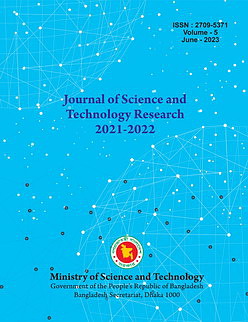Assessment of Suitable Growth Condition of Salvinia spp. for Sustainability of Floating Agriculture to Mitigate Climate Change Challenges on Crop Cultivation
DOI:
https://doi.org/10.3329/jscitr.v5i1.74006Keywords:
Floating agriculture, Sustainability, Salvinia, Nutrient, Growth, and Development.Abstract
Floating agriculture is an indigenous cultivation practice in the southern waterlogged areas of Bangladesh. Water hyacinth and other macrophytes were utilized in this agricultural method to prepare the floating bed. Among the numerous macrophytes used as mulch in floating beds, Salvinia spp. is a common species. To meet the local farmer's demand, it is necessary to improve the growth rates of these macrophytes so that they can be available year-round for preparing floating beds. For this purpose, an experiment was conducted to assess the growth conditions of Salvinia spp. under various nutritional media. Salvinia molesta and Salvinia cucullata were cultivated in four healthy media to carry out the experiment. The experimental design used in the present investigation was a split-plot arrangement in a Randomized Block Design (RBD), where four nutrients (NO3-; PO43-; NH4+ and Urea) were assigned to the main plots, while five different concentrations of nutrient (0, 1, 5, 10 and 15 mM) were given to the sub-plots. Salvinia spp. growth was examined in terms of morphological and physiological responses and the distribution of nutrients. The highest relative growth rate (RGR) and biomass production (g DW) were found in the medium with one mM and five mM PO43- in the case of S. molesta and one mM NH4+ in the case of S. cucullata. It was also observed that the plant growth rate became suppressed when this macrophyte grew above the 5mM of nutrient concentration, and this suppressed condition turned into a toxic state when the organic nutrient concentration reached a concentration of 15 mM or above. In the case of Urea, this harmful condition starts with a concentration of 5 mM or more for S. molesta and any concentration for S. cucullata.Nonetheless, very few variations were found in how various plant tissues and species absorbed mineral concentrations. The overall findings from this experiment indicate that both PO43- and NH4+ concentrations of 1 mM and 5 mM are comparatively more suitable than NO3- and Urea for the growth and multiplication of Salvinia spp. However, more research is required in addition to varying the quantities of phosphate and ammonium to make a definitive choice.
J. of Sci. and Tech. Res. 5(1): 53-62, 2023
269
233
Downloads
Published
How to Cite
Issue
Section
License
Copyright (c) 2023 Nargis Sultana, Shawon Mitra, Subroto Kumar Das

This work is licensed under a Creative Commons Attribution 4.0 International License.




